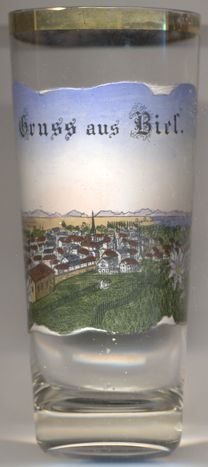

|
| SCHWEIZ / SUISSE / SVIZZERA / SVIZRA | SWITZERLAND |
| Bern / Berne / Berna / Berna |
 Biel / Bienne is situated at an elevation of 434 m on the northeastern shore of Lake Biel in the northern part of the Swiss canton
of Berne, about 27 km northwest of the city of Bern. With a population of about 55,100 (2022) it is the second-largest city of
the canton and also the second-largest bilingual city of Switzerland.
Biel / Bienne is situated at an elevation of 434 m on the northeastern shore of Lake Biel in the northern part of the Swiss canton
of Berne, about 27 km northwest of the city of Bern. With a population of about 55,100 (2022) it is the second-largest city of
the canton and also the second-largest bilingual city of Switzerland.
The shoreline of Lake Biel has been inhabited since at least the Neolithic age. After the Roman conquest, the region was part of Germania Superior. In the 5th century, the area was invaded by the Burgundians, and by the medieval period became part of Upper Burgundy. During the 6th or 7th century, the Germanic-speaking Alamanni moved into the area around Lake Biel. In 999 the lands around Lake Biel were granted to the Bishopric of Basel. Through the bishop of Basel, the counts of Neuchâtel began to exercise their power in the foothills of the Jura Mountains. The town was mentioned in 1142 as Apud Belnam. Biel remained under the jurisdiction of the Bishop of Basel throughout the 11th to 18th centuries. However, the early history of the town is filled with conflict between the town council and the bishop's representative. In 1252, the town council partly succeeded in becoming a free imperial city. While it officially remained part of the lands of the Prince-Bishopric of Basel, starting in the 13th century Biel began making alliances with neighboring nobles and cities. In 1279 it allied with Bern. This first alliance was followed in 1311 by an alliance with Fribourg, a 1334 alliance with Solothurn, 1342 with Murten and 1395 with La Neuveville. The alliance with Bern became an eternal alliance in 1352, as Bern itself joined the Old Swiss Confederacy. Contradictory obligations to the Bishop of Basel and to the Imperial City of Bern led to a war in 1367. During the war, Biel was burned and the Bishop's castle was destroyed. Biel was considered an associate of the Swiss Confederacy during the 15th century, and after its participation in the Burgundy Wars even came to be recognized as a full member by 1494. Even though Biel remained nominally under the control of the Catholic bishops of Basel, in 1528 it converted to the new Protestant faith. The French Revolution changed the political situation in Biel/Bienne. In 1798, Bienne and its neighboring communities were incorporated as the Canton de Bienne into the département du Mont-Terrible of the First French Republic. Two years later, in 1800, it went to the département du Haut-Rhin. After the collapse of the French Empire, the Congress of Vienna (1814) granted most of the territory of the bishopric to the canton of Bern.
In 2004 the municipality of Biel/Bienne was awarded the Wakker Prize of the Swiss Heritage Society for the development and
preservation of its architectural heritage.
Other cities that have been awarded this prize and which are depicted on glasses of this collection are:
Altdorf (2007),
Baden (2020),
Basel (1996),
Bern (1997),
Genève (2000),
La Chaux-de-Fonds (2011),
Lausanne West (Bussigny-près-Lausanne, Chavannes-près-Renens, Crissier, Ecublens, Lausanne, Prilly, Renens, Saint-Sulpice, Villars-Sainte-Croix) (2011),
Montreux (1990),
Sankt Gallen (1992),
Solothurn (1980),
Stein am Rhein (1972),
Wil (1984).
[https://de.wikipedia.org/wiki/Biel/Bienne, https://en.wikipedia.org/wiki/Biel/Bienne]
![[scale]](lineal.jpg)